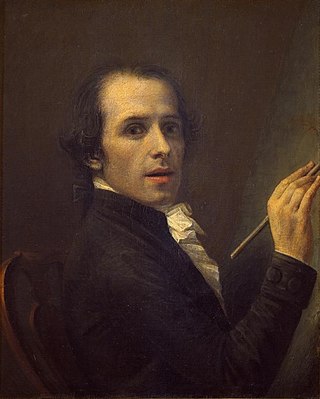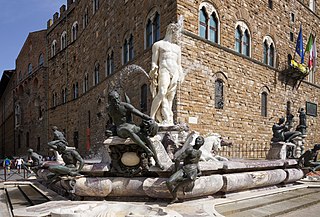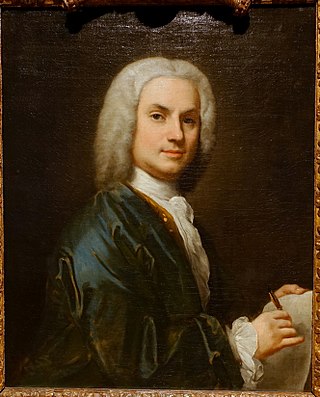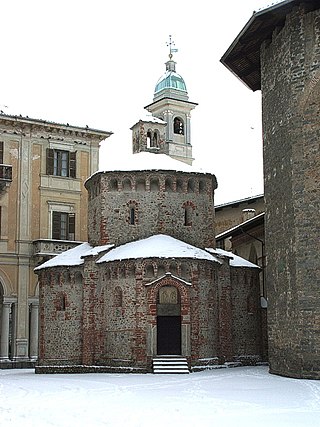Related Research Articles

Antonio Canova was an Italian Neoclassical sculptor, famous for his marble sculptures. Often regarded as the greatest of the Neoclassical artists, his sculpture was inspired by the Baroque and the classical revival, and has been characterised as having avoided the melodramatics of the former, and the cold artificiality of the latter.

Bartolomeo Ammannati was an Italian architect and sculptor, born at Settignano, near Florence, Italy. He studied under Baccio Bandinelli and Jacopo Sansovino and closely imitated the style of Michelangelo.

Jacopo Amigoni, also named Giacomo Amiconi, was an Italian painter of the late-Baroque or Rococo period, who began his career in Venice, but traveled and was prolific throughout Europe, where his sumptuous portraits were much in demand.

David is a masterpiece of Italian Renaissance sculpture in marble created from 1501 to 1504 by Michelangelo. With a height of 5.17 metres, the David was the first colossal marble statue made in the High Renaissance, and since classical antiquity, a precedent for the 16th century and beyond. David was originally commissioned as one of a series of statues of twelve prophets to be positioned along the roofline of the east end of Florence Cathedral, but was instead placed in the public square in front of the Palazzo della Signoria, the seat of civic government in Florence, where it was unveiled on 8 September 1504. In 1873, the statue was moved to the Galleria dell'Accademia, Florence. In 1910 a replica was installed at the original site on the public square.
Events from the year 1967 in art.

Biella is a city and comune (municipality) in the northern Italian region of Piedmont, the capital of the province of the same name, with a population of 44,324 as of 31 December 2017. It is located about 80 kilometres northeast of Turin and at about the same distance west-northwest of Milan.

A durag is a close-fitting cloth tied around the top of the head to protect the hair; similarly a wave cap is a close-fitting cap for the same purpose. Durags may be worn to accelerate the development of long curly/kinky hair, waves or locks in the hair; to maintain natural oils in hair ; to stop hair breakage; to manage hair in general; or to keep hair, wave patterns and braids from shifting while sleeping. Durags are also worn as an identity-making fashion choice, popular in Black culture and African-American culture.

Arte Povera was an art movement that took place between the end of the 1960s and the beginning of the 1970s in major cities throughout Italy and above all in Turin. Other cities where the movement was also important are Milan, Rome, Genoa, Venice, Naples and Bologna. The term was coined by Italian art critic Germano Celant in 1967 and introduced in Italy during the period of upheaval at the end of the 1960s, when artists were taking a radical stance. Artists began attacking the values of established institutions of government, industry, and culture.

Cornelia Ann Parker is an English visual artist, best known for her sculpture and installation art.
Cameron Sinclair is a Scottish composer, conductor and percussionist based in London.

Michelangelo Pistoletto is an Italian painter, action and object artist, and art theorist. Pistoletto is acknowledged as one of the main representatives of the Italian Arte Povera. His work mainly deals with the subject matter of reflection and the unification of art and everyday life in terms of a Gesamtkunstwerk.

Line 1 is a Naples Metro line that runs from Piscinola Scampia in suburban north-west Naples to Garibaldi in southeast Naples. Printed in yellow on the map, it serves 19 stations, 16 of which are underground, over 18.8 kilometres (11.7 mi). It is operated by ANM. The line has been renamed Metrò dell'Arte reflecting the presence of contemporary art works installed in some of its stations.

The Venetian painter Titian and his workshop made at least six versions of the same composition showing Danaë, painted between about 1544 and the 1560s. The scene is based on the mythological princess Danaë, as – very briefly – recounted by the Roman poet Ovid, and at greater length by Boccaccio. She was isolated in a bronze tower following a prophecy that her firstborn would eventually kill her father. Although aware of the consequences, Danaë was seduced and became pregnant by Zeus, who, inflamed by lust, descended from Mount Olympus to seduce her in the form of a shower of gold.

The Venus Callipyge, also known as the Aphrodite Kallipygos or the Callipygian Venus, all literally meaning "Venus of the beautiful buttocks", is an Ancient Roman marble statue, thought to be a copy of an older Greek original. In an example of anasyrma, it depicts a partially draped woman, raising her light peplos to uncover her hips and buttocks, and looking back and down over her shoulder, perhaps to evaluate them. The subject is conventionally identified as Venus (Aphrodite), though it may equally be a portrait of a mortal woman.

Gilberto Zorio is an Italian artist associated with the Italian Arte Povera movement. Zorio's artwork shows his fascination with natural processes, alchemical transformation, and the release of energy. His sculptures, paintings, and performances are often read as metaphors for revolutionary human action, transformation, and creativity. He is known for his use of materials including: incandescent electric light tubes, steel, pitch, motifs, and processes through the use of evaporation and oxidation. He also creates precarious installations using fragile materials such as Stella di Bronzo and Acidi within his work.
Emilia Telese is an Italian artist whose practice includes performance, visual, site-specific and video art, interactive and body-responsive technology, installation, literature and public art. She lives and works between Brighton, UK, Foggia, Italy, and Reykjavik, Iceland. Telese graduated in 1996 with a BA (Honours) in painting from the Fine Arts Academy, Florence, focusing on 14th-century techniques, Arte Povera and political performance. In 1997 she studied acid-based printmaking techniques at the University of Brighton, where she continues to lecture. In addition she lectures at other institutions in the UK and internationally, specialising in the relationship between art, economics and professional practice. Her work Life Begins at Land's End (2013) was part of Rebirth Day, a concept organised by Michelangelo Pistoletto. Pistoletto named her a Third Paradise Ambassador, which is a small group of people chosen by him to embody the spirit of his Third Paradise concept. Her videos, along with works by other artists, were shown at the Musee du Louvre in Paris. In 2015 her exhibition Modern Women was featured at Airspace Gallery in Stoke-on-Trent, with artist Binita Walia.

Blenheim Art Foundation (BAF) is a multi-award-winning non-profit organisation that presents large-scale contemporary art exhibitions at Blenheim Palace.
The 50th Venice Biennale, held in 2003, was an exhibition of international contemporary art, with 64 participating nations. The Venice Biennale takes place biennially in Venice, Italy. Prizewinners of the 50th Biennale included: Michelangelo Pistoletto and Carol Rama, Peter Fischli and David Weiss, Oliver Payne and Nick Relph, Avish Khebrehzadeh, Luxembourg with Su-Mei Tse.

Jorit Ciro Cerullo, known mononymously as Jorit, is an Italian street artist. He is known for painting murals depicting faces of people with red streaks on their cheeks.

Venus and Cupid is an oil painting on panel of c. 1533 by Pontormo, from a lost drawing or cartoon by Michelangelo, in the Galleria dell'Accademia in Florence. A preparatory study is in the British Museum and a copy by Michele di Ridolfo del Ghirlandaio is in the Palazzo Colonna in Rome. Other copies are in the Royal Collection at Kensington Palace, in Hildesheim, a small version in Geneva attributed to Michele Tosini and two in the Museo di Capodimonte in Naples. Giorgio Vasari made three copies for Ottaviano de' Medici.
References
- 1 2 3 "Michelangelo Pistoletto: Venus of the Rags". Tate. Archived from the original on 1 May 2023. Retrieved 13 July 2023.
- 1 2 3 4 Schrader, Adam (12 July 2023). "An Alleged Arson Attack Has Destroyed Michelangelo Pistoletto's 'Venus Of The Rags' Installation in Naples". ARTnews . Archived from the original on 13 July 2023. Retrieved 13 July 2023.